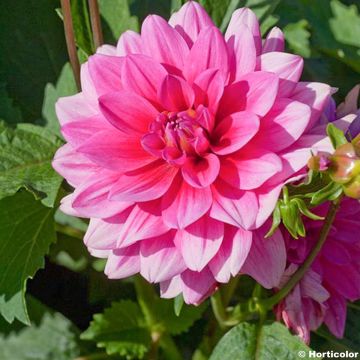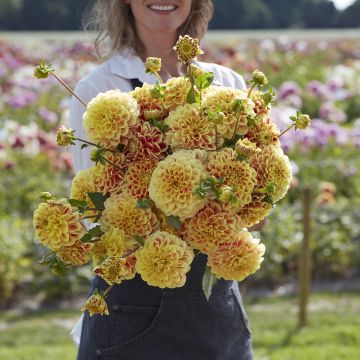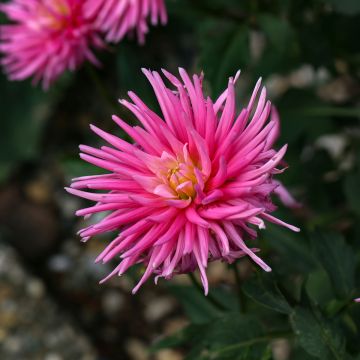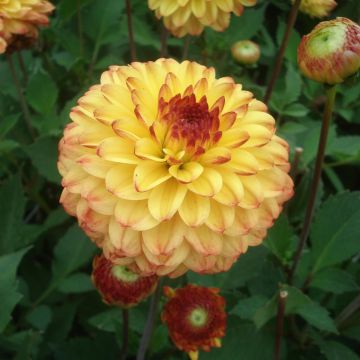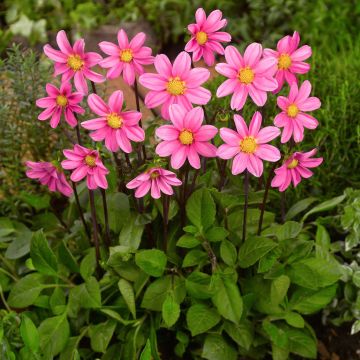

Dahlia décoratif Ellen Houston


Dahlia Ellen Houston
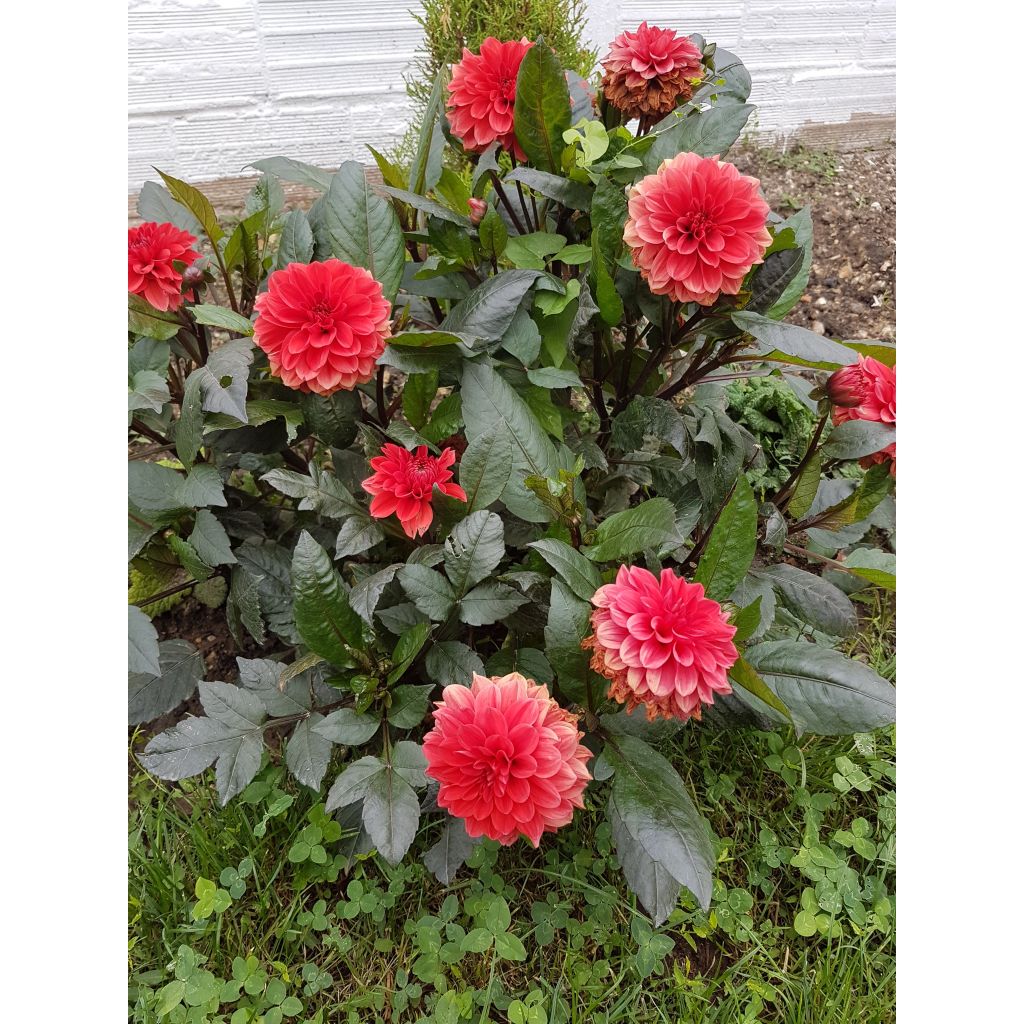

Dahlia Ellen Houston
Dahlia Ellen Houston
Dahlia Ellen Houston
Dahlia
Beautifully bloomed, very lovely flower bed
Monique G., 10/12/2018
This item cannot be shipped to the selected country
Delivery charge from €5.90
More information
Schedule delivery date,
and select date in basket
This plant carries a 6 months recovery warranty
More information
We guarantee the quality of our plants for a full growing cycle, and will replace at our expense any plant that fails to recover under normal climatic and planting conditions.
From €5.90 for pickup delivery and €6.90 for home delivery
Express home delivery from €8.90.

Does this plant fit my garden?
Set up your Plantfit profile →
Description
The Dahlia Ellen Houston is a decorative dahlia with coral flowers and almost black foliage.
A plant with a thousand faces, the Dahlia originally from the high plateaus of Mexico, now has around 20,000 varieties. This tuberous plant was initially cultivated as a root vegetable for consumption. But its poor taste qualities gave way to its exuberant flowering. Since then, interest in this very floriferous Asteraceae has never waned.
The Dahlia Ellen Houston is a small decorative dahlia. The plant will reach 50 cm (20in) in height and 40 cm (16in) in width. It has a bushy habit and, as a low variety, has a stocky appearance. Its very branched stems are hollow. Its leaves are opposite, pinnate, meaning they are divided into 3 or 5 leaflets, which have very denticulate lobes. The stems and leaves are a dark bronze colour, almost black, which greatly contributes to the plant's decorative effect.
The flowers of decorative dahlias are thicker than they are wide and are often large in size. The flowers of the Ellen Houston variety are 10 cm (4in) in diameter, full and well double. The outermost ligules are slightly tubular and incurved (curved upwards). They are coral red to bright orange. The central florets are shorter and form a tender green bud as they have not yet reached maturity.
The flowering period of dahlias is exceptionally long. Our variety begins in July and ends in October. To encourage repeat flowering and extend this flowering period, make sure to remove faded flowers. Even better, cut them regularly to create attractive colourful bouquets by combining various varieties.
Dahlias are easy to grow and, for a more generous flowering, it is good to follow a few simple rules: they are sun-loving plants that require a lot of sunlight. Plant the tubers in full sun as soon as the last frosts are over. Rich, fresh and well-drained soils are welcome. Excessive moisture can cause the tubers to rot. Feel free to amend the soil with compost and sand if necessary.
Dahlias are very attractive to bees, which is valuable as sources of nectar become scarce in autumn. Along borders or in flower beds, combine the colours of this dahlia with Cape Lilies, Shangri La Peach Verbena, create a colour contrast with one of the many varieties of asters, and add a wispy grass for a refined and romantic display.
Report an error about the product description
Dahlia Ellen Houston in pictures




Plant habit
Flowering
Foliage
Botanical data
Dahlia
Ellen Houston
Asteraceae
Dahlia
Cultivar or hybrid
Other Ornamental Dahlias
Planting and care
Planting period
Intended location
Care
-
, onOrder confirmed
Reply from on Promesse de fleurs
Dahlias
Haven't found what you were looking for?
Hardiness is the lowest winter temperature a plant can endure without suffering serious damage or even dying. However, hardiness is affected by location (a sheltered area, such as a patio), protection (winter cover) and soil type (hardiness is improved by well-drained soil).

Photo Sharing Terms & Conditions
In order to encourage gardeners to interact and share their experiences, Promesse de fleurs offers various media enabling content to be uploaded onto its Site - in particular via the ‘Photo sharing’ module.
The User agrees to refrain from:
- Posting any content that is illegal, prejudicial, insulting, racist, inciteful to hatred, revisionist, contrary to public decency, that infringes on privacy or on the privacy rights of third parties, in particular the publicity rights of persons and goods, intellectual property rights, or the right to privacy.
- Submitting content on behalf of a third party;
- Impersonate the identity of a third party and/or publish any personal information about a third party;
In general, the User undertakes to refrain from any unethical behaviour.
All Content (in particular text, comments, files, images, photos, videos, creative works, etc.), which may be subject to property or intellectual property rights, image or other private rights, shall remain the property of the User, subject to the limited rights granted by the terms of the licence granted by Promesse de fleurs as stated below. Users are at liberty to publish or not to publish such Content on the Site, notably via the ‘Photo Sharing’ facility, and accept that this Content shall be made public and freely accessible, notably on the Internet.
Users further acknowledge, undertake to have ,and guarantee that they hold all necessary rights and permissions to publish such material on the Site, in particular with regard to the legislation in force pertaining to any privacy, property, intellectual property, image, or contractual rights, or rights of any other nature. By publishing such Content on the Site, Users acknowledge accepting full liability as publishers of the Content within the meaning of the law, and grant Promesse de fleurs, free of charge, an inclusive, worldwide licence for the said Content for the entire duration of its publication, including all reproduction, representation, up/downloading, displaying, performing, transmission, and storage rights.
Users also grant permission for their name to be linked to the Content and accept that this link may not always be made available.
By engaging in posting material, Users consent to their Content becoming automatically accessible on the Internet, in particular on other sites and/or blogs and/or web pages of the Promesse de fleurs site, including in particular social pages and the Promesse de fleurs catalogue.
Users may secure the removal of entrusted content free of charge by issuing a simple request via our contact form.
The flowering period indicated on our website applies to countries and regions located in USDA zone 8 (France, the United Kingdom, Ireland, the Netherlands, etc.)
It will vary according to where you live:
- In zones 9 to 10 (Italy, Spain, Greece, etc.), flowering will occur about 2 to 4 weeks earlier.
- In zones 6 to 7 (Germany, Poland, Slovenia, and lower mountainous regions), flowering will be delayed by 2 to 3 weeks.
- In zone 5 (Central Europe, Scandinavia), blooming will be delayed by 3 to 5 weeks.
In temperate climates, pruning of spring-flowering shrubs (forsythia, spireas, etc.) should be done just after flowering.
Pruning of summer-flowering shrubs (Indian Lilac, Perovskia, etc.) can be done in winter or spring.
In cold regions as well as with frost-sensitive plants, avoid pruning too early when severe frosts may still occur.
The planting period indicated on our website applies to countries and regions located in USDA zone 8 (France, United Kingdom, Ireland, Netherlands).
It will vary according to where you live:
- In Mediterranean zones (Marseille, Madrid, Milan, etc.), autumn and winter are the best planting periods.
- In continental zones (Strasbourg, Munich, Vienna, etc.), delay planting by 2 to 3 weeks in spring and bring it forward by 2 to 4 weeks in autumn.
- In mountainous regions (the Alps, Pyrenees, Carpathians, etc.), it is best to plant in late spring (May-June) or late summer (August-September).
The harvesting period indicated on our website applies to countries and regions in USDA zone 8 (France, England, Ireland, the Netherlands).
In colder areas (Scandinavia, Poland, Austria...) fruit and vegetable harvests are likely to be delayed by 3-4 weeks.
In warmer areas (Italy, Spain, Greece, etc.), harvesting will probably take place earlier, depending on weather conditions.
The sowing periods indicated on our website apply to countries and regions within USDA Zone 8 (France, UK, Ireland, Netherlands).
In colder areas (Scandinavia, Poland, Austria...), delay any outdoor sowing by 3-4 weeks, or sow under glass.
In warmer climes (Italy, Spain, Greece, etc.), bring outdoor sowing forward by a few weeks.


































